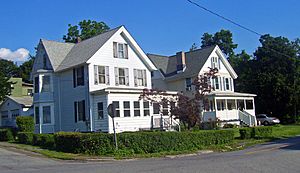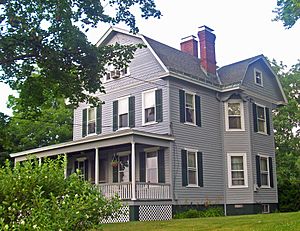Chelsea, Dutchess County, New York facts for kids
Chelsea is a small community, also called a hamlet, in Dutchess County, New York. It's part of the Town of Wappinger. Chelsea is located right on the Hudson River in the southwestern part of the town. It has its own ZIP Code (12512) and telephone area code (845). It even has its own fire department!
Chelsea is mostly a place where people live. There's a marina on the river where boats can dock. Just north of Chelsea, there's a big pumping station. This station is used by the New York City water supply system during dry times. It takes water directly from the Hudson River. This spot is special because the river water here is fresh enough to drink, even when it's very dry.
Contents
A Look Back: Chelsea's History
The area we now call Chelsea was first known as Low Point. This name came from a low piece of land that stuck out into the river. It also helped tell it apart from another nearby place called High Point (now New Hamburg). Around 1800, a man named Abram Gerow moved to Low Point. He started a business making barrels, called a cooperage. The streets of the area were planned out in 1812.
How Chelsea Got Its Name
Low Point kept its name until the Hudson River Railroad was finished. Then, it was renamed Carthage. But there was another Carthage in Jefferson County, which caused mail to get mixed up. So, the name was changed again to Carthage Landing. Finally, in 1901, when the railroad built a new station, the name became Chelsea.
River Life and Shipyards
Around 1820, Cornelius Carman started a shipyard at Carthage Landing. Here, boats like sloops (small sailing ships) and steamboats were built. However, his shipyard faced tough competition from Fishkill Landing. That area had better facilities for shipping farm goods. Carman was important because he introduced the first "centerboard" on a sloop called the Freedom. A centerboard is a fin that helps a sailboat steer better.
In 1828, Carman built the Plow Boy. This was a steam ferry-boat that carried people and goods between Fishkill Landing and Newburgh. It was the first steam ferry to do this! Later, in 1830, another steamboat called the William Young was built at Low Point. It traveled between Newburgh and Albany. Today, the Chelsea Yacht Club is located where the old shipyard used to be.
From 1868 to 1888, Low Point was a busy place for shipping. Many sloops and schooners (another type of sailing ship) operated from here. Farmers from far away, even Connecticut, would line up their wagons for over a mile. They waited to load their crops onto boats and pick up supplies. A post office was set up in Low Point around 1840.
Changes with the Railroad
When the Hudson River Railroad was built, shipping goods by water from Low Point became less popular. In 1856, Starr B. Knox bought the shipyard property. He turned a storage building into a flour mill. But this mill couldn't compete with bigger mills in the west after the Union Pacific Railroad opened. So, it closed down.
Later, in 1878, the property was used by the Wallkill Cement Company. This company made Portland cement, which was used to build the piers of the Poughkeepsie Bridge. The company later moved, and the mill was torn down in 1895.
Community Life and Churches
By 1866, Carthage Landing had a post office, a school, several stores, a hotel, and two churches. About 300 people lived there. The Methodist Church was started in 1823, and its building was finished ten years later. St. Mark's Episcopal Church was founded in 1865. Its church building, dedicated in 1869, is a beautiful example of "Carpenter Gothic" style.
Chelsea Fire Company: A Community Story
The Chelsea Fire Company was started on April 1, 1946. Before this, the area didn't have good fire protection. A group of people decided to do something about it. They voted to form a fire company. Instead of waiting for money from a bond, nineteen men put in $1,800 of their own money. They bought a used 1943 Ford Pumper fire truck from the war. This was their first piece of equipment!
Today, the Chelsea Fire District covers about eight square miles. This includes parts of the Town of Wappinger and the Town of Fishkill. It also covers a part of the Hudson River. The fire district protects places like Stony Kill Farm, a large state farm, and Dutchess Stadium. This stadium is home to the Hudson Valley Renegades, a minor league baseball team.
Today, Chelsea is home to the Chelsea Yacht Club, two historic churches, a post office, and several homes listed on the national historic register.
Historic Buildings in Chelsea
Chelsea has some interesting old buildings that tell stories about its past.
Chelsea Grammar School
The old Chelsea Grammar School is on Liberty Street. It was the first public schoolhouse in the Town of Wappinger. Children went there up until high school. It's a well-preserved one-room schoolhouse from the late 1800s, when Chelsea was a busy river port. In 1987, it was added to the National Register of Historic Places. The school stopped being used in the mid-1900s when smaller local school districts joined together. Now, the local fire department uses half of it as a community center. The United States Postal Service uses the other half as the local post office for the 12512 ZIP Code.
Captain Moses W. Collyer House
The Captain Moses W. Collyer House, also known as "Driftwood," is on River Road South in Chelsea. It was added to the National Register of Historic Places in 1987. Moses Collyer was a riverboat captain on the nearby Hudson River from 1899 until he passed away in 1942. He helped write a book called "The Sloops of the Hudson." This book was a memoir and history of the years when sailboats were the main way to travel on the river. It's considered a very important book about that time and the boats used then.




